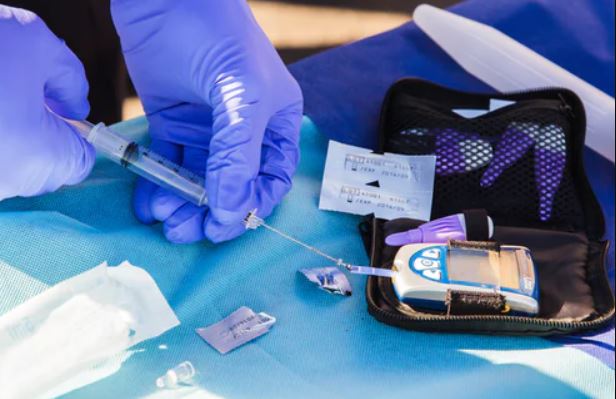Overview Of Diabetes
Diabetes is a disease that occurs when blood glucose, also called blood sugar, is too high. Blood glucose is the main source of energy and comes from the food we eat. Insulin, a hormone made by the pancreas, helps glucose from food get into the cells to be used for energy. Sometimes the body doesn’t make enough—or any—insulin or doesn’t use insulin well. Glucose then stays in the blood and doesn’t reach cells.
Over time, having too much glucose in the blood can cause health problems. Although this condition has no cure, steps can be taken to manage it and stay healthy.
Causes Of Diabetes
Insulin is a hormone produced by the pancreas to control blood sugar. This condition can be caused by too little insulin, resistance to insulin, or both.
To understand this condition, it is important to first understand the normal process by which food is broken down and used by the body for energy.
Several things happen when food is digested and absorbed:
- A sugar called glucose enters the bloodstream. Glucose is a source of fuel for the body.
- An organ called the pancreas makes insulin. The role of insulin is to move glucose from the bloodstream into muscle, fat, and other cells, where it can be stored or used as fuel.
People with diabetes have high blood sugar because their body cannot move sugar from the blood into muscle and fat cells to be burned or stored for energy, and/or because their liver makes too much glucose and releases it into the blood.
This is because either:
- Their pancreas does not make enough insulin
- Their cells do not respond to insulin normally
- Both of the above
Symptoms
Symptoms of diabetes include:
- increased thirst and urination
- increased hunger
- fatigue
- blurred vision
- numbness or tingling in the feet or hands
- sores that do not heal
- unexplained weight loss
Symptoms of type 1 diabetes can start quickly, in a matter of weeks. Symptoms of type 2 diabetes often develop slowly—over the course of several years—and can be so mild that you might not even notice them. Many people with type 2 have no symptoms. Some people do not find out they have the disease until they have diabetes-related health problems, such as blurred vision or heart trouble.
Treatment Of Diabetes
The major goal in treating type 1 and type 2 diabetes is to control blood sugar (glucose) levels within the normal range, with minimal excursions to low or high levels.
Type 1 diabetes is treated with:
- insulin,
- exercise, and a
- type 1 diet.
Type 2 diabetes is treated:
- First with weight reduction, a type 2 diet, and exercise
- Medications (oral or injected) are prescribed when these measures fail to control the elevated blood sugars of type 2.
- If other medications become ineffective treatment with insulin may be initiated.
Other
Common types of diabetes:
- Type I: Also known as juvenile diabetes, this type occurs when the body fails to produce insulin. People with type I diabetes are insulin-dependent, which means they must take artificial insulin daily to stay alive.
- Type 2: Type 2 diabetes affects the way the body uses insulin. While the body still makes insulin, unlike in type I, the cells in the body do not respond to it as effectively as they once did. This is the most common type, according to the National Institute of Diabetes and Digestive and Kidney Diseases, and it has strong links with obesity.
- Gestational diabetes: This type occurs in women during pregnancy when the body can become less sensitive to insulin. Gestational diabetes does not occur in all women and usually resolves after giving birth.
What health problems can people with diabetes develop?
Over time, high blood glucose leads to problems such as
- heart disease
- stroke
- kidney disease
- eye problems
- dental disease
- nerve damage
- foot problems
Prediabetes
Doctors refer to some people as having prediabetes or borderline diabetes when blood sugar is usually in the range of 100 to 125 milligrams per deciliter (mg/dL).
Normal blood sugar levels sit between 70 and 99 mg/dL, whereas a person with this condition will have a fasting blood sugar higher than 126 mg/dL.
The prediabetes level means that blood glucose is higher than usual but not so high as to constitute diabetes.
People with prediabetes are, however, at risk of developing type 2 diabetes, although they do not usually experience the full symptoms.
The risk factors for prediabetes and type 2 are similar. They include:
- being overweight
- a family history
- having a high-density lipoprotein (HDL) cholesterol level lower than 40 mg/dL or 50 mg/dL
- a history of high blood pressure
- having gestational diabetes or giving birth to a child with a birth weight of more than 9 pounds
- a history of polycystic ovary syndrome (PCOS)
- being more than 45 years of age
- having a sedentary lifestyle
If a doctor identifies that a person has prediabetes, they will recommend that the individual makes healthful changes that can ideally stop the progression to type 2 diabetes. Losing weight and having a more healthy diet can often help prevent the disease.



